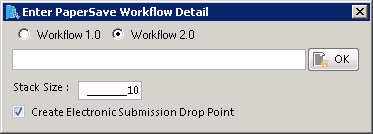| Show/Hide Hidden Text |
A PaperSave Workflow can be created either by using predefined templates or by creating a custom workflow using the various options provided.
Steps to create PaperSave Workflow:
1. Expand Workflows section from PaperSave Settings Form.
2. Click on Workflows. The Workflow section will open.
3. Select the Host Application (here, Student Information System), Module, Transaction Type, and Document Type for which the Workflow is to be created. Click on Add Workflow button available in the ribbon as displayed below.
4. Click Add Workflow on the toolbar. The PaperSave Workflow Name Screen will appear as displayed below. Select Workflow 2.0 option, enter the name of the Workflow in the available text-box. Enter the value for Stack Size. You can check Create Electronic Submission Drop Point checkbox, if you wish to create Drop Point for this newly created Workflow. DropPoint would be named same as Workflow Name with suffix 'Electronic Submission'. Click on OK button.
Note: |
||||||
|

Note: |
||||
|
5. As you click on OK button, you will be directed to Workflow Designer form as displayed below. You have 2 ways to design a Workflow, viz; using pre-defined Workflow Templates or using different Steps & Activities available under Design Workflow Toolbox. You also have the ability to load a Workflow in the designer area using Load Workflow From File button. Click here to know more on Designing a Workflow.
Note: |
While editing an existing Workflow, you need to click Design Workflow option on the toolbar to open the Workflow in the design mode. |